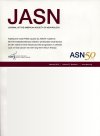Combined Kelch-like 3 and Cullin 3 Degradation is a Central Mechanism in Familial Hyperkalemic Hypertension in Mice
Mutations in the ubiquitin ligase scaffold protein Cullin 3 (CUL3) gene cause the disease familial hyperkalemic hypertension (FHHt). In the kidney, mutant CUL3 (CUL3-9) increases abundance of With-No-Lysine (K) Kinase 4 (WNK4), inappropriately activating sterile 20/SPS-1–related proline/alanine-rich kinase (SPAK), which then phosphorylates and hyperactivates the Na+Cl– cotransporter (NCC). The precise mechanism by which CUL3-9 causes FHHt is unclear. We tested the hypothesis that reduced abundance of CUL3 and of Kelch-like 3 (KLHL3), the CUL3 substrate adaptor for WNK4, is mechanistically important. Because JAB1, an enzyme that inhibits CUL3 activity by removing the ubiquitin-like protein NEDD8, cannot interact with CUL3-9, we also determined whether Jab1 disruption mimicked the effects of CUL3-9 expression.
We used an inducible renal tubule-specific system to generate several mouse models expressing CUL3-9, mice heterozygous for both CUL3 and KLHL3 (Cul3+/–/Klhl3+/–), and mice with short-term Jab1 disruption (to avoid renal injury associated with long-term disruption).
Renal KLHL3 was higher in Cul3–/– mice, but lower in Cul3–/–/9 mice and in the Cul3+/–/9 FHHt model, suggesting KLHL3 is a target for both WT and mutant CUL3. Cul3+/–/Klhl3+/– mice displayed increased WNK4-SPAK activation and phospho-NCC abundance and an FHHt-like phenotype with increased plasma [K+] and salt-sensitive blood pressure. Short-term Jab1 disruption in mice lowered the abundance of CUL3 and KLHL3 and increased the abundance of WNK4 and phospho-NCC.
Jab1–/– mice and Cul3+/–/Klhl3+/– mice recapitulated the effects of CUL3-9 expression on WNK4-SPAK-NCC. Our data suggest degradation of both KLHL3 and CUL3 plays a central mechanistic role in CUL3-9–mediated FHHt.



